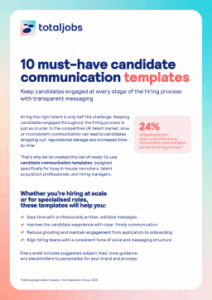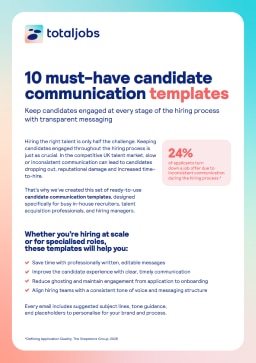
Why disengaged candidates are costing more than you think
Table of Contents
- Why candidates disengaged
- The recruiter’s reality
- Mapping the candidate journey
- Tips to keep candidates engaged
- Technology and tools
- Final takeaways and next steps
- FAQs

Candidate Communication Templates
Candidate drop-off is one of the biggest challenges facing recruiters today. In fact, our research shows that 28% of candidates exit the hiring process before it’s complete, often due to poor communication, slow timelines, or unclear expectations.
This delays hiring, drives up costs, and can ultimately mean employers miss out on securing the talented candidates they need.
In this article, we unpack the real cost of candidate disengagement and share practical candidate engagement strategies to help you keep talent interested at every stage of the hiring funnel.
Why candidates disengaged (and where it’s costing you)
Before looking to fix candidate disengagement, it’s first important to understand where and why it happens. Candidate drop-offs often stem from specific pain points within the recruitment journey that erode trust, interest, or motivation.
By looking at both candidate experience and the operational challenges that recruiters face, you can start to pinpoint the gaps and missed opportunities that are driving top talent away.
The candidate perspective
Candidates today expect a hiring process that is clear, efficient, and respectful of their time. When these expectations aren’t met, interest can fade quickly, especially in competitive industries where other offers are just a click away.
Here’s what our research reveals about the reasons candidates disengage:
- Role did not match expectations (30%)
- Received a better offer (28%)
- Process took too long (25%)
These issues can not only result in immediate drop-off but can also hurt an employer’s reputation in the long run, especially when candidates choose to share negative experiences with peers or on public forums.
Candidates want faster feedback (34%), a shorter process (30%), and more clarity on role requirements (39%).
The recruiter’s reality
While candidate expectations rise, recruiters are under increasing pressure, often juggling multiple vacancies, admin-heavy tasks, and complex internal coordination.
After the interview finishes, the note-taking part and then needing to input all those notes into their profile… takes a lot of work
Our research shows that:
- Recruiters handle 4 roles per month, receieving 20 applications on average per vacancy
- They spend 3.6 hours per vacancy screening CVs, but only 50% of applications are relevant
- 72% say screening irrelevant applications slows them down significantly
- Manual admin tasks take 17.7 hours per vacancy, costing recruiters an estimated £16,728 per year
Furthermore, waiting for feedback from stakeholders and processing interview notes take a long time, impacting the candidate experience by elongating the process.
50%
of recruiters say manual tasks take too much time
Due to a slower timeline and poor communication, candidates can end up removing themselves from the process.
Map the candidate journey to spot drop-off points
Understanding where candidates disengage starts with mapping out the key moments in their journey. Below are where the touch points in the hiring process can be optimised for a better candidate experience.
Key engagement moments
- Application submission: The candidate experience begins the moment they hit ‘submit’. Simple, user-friendly application processes and immediate confirmation messages can help set a positive tone and reduce early drop-off.
- First contact: Prompt, clear communication after application submissions is critical. Whether it’s a phone call, email, or automated message, this first outreach should reassure candidates that their application is being considered and outlines what to expect next.
- Interview stage(s): Scheduling and conducting interviews can be a source of frustration of not managed effectively. Flexibility, clear instructions, and timely updates about interview logistics help maintain candidate interest and can help reduce no-shows or cancellations.
- Post-interview follow-up: Candidates want to know where they stand as soon as possible after their interview. Providing timely, personalised feedback, even if it’s a rejection, can build trust and boost employer branding.
- Offer stage: When extending an offer, clarity and transparency are always key. Clear communication about the offer details, deadlines, and next steps helps prevent candidates from reconsidering or accepting competing offers.
Removing friction across the journey
Looking at which touchpoints they lose candidates regularly gives organisations the opportunity to improve. Whether it’s because of delays, miscommunication or complex application steps.
Looking at which touchpoints they lose candidates regularly gives organisations the opportunity to improve. Whether it’s because of delays, miscommunication or complex application steps.
Key questions to consider:
- Are we making it easy for candidates to apply and engage?
- Is our communication timely, clear, and personalised?
- Are interviews scheduled efficiently with minimal back-and-forth?
- Do candidates receive prompt feedback and updates?
- Is the offer process straightforward and supportive?
By proactively addressing these types of questions and smoothing out the candidate journey, recruiters can significantly reduce drop-offs and improve engagement, leading to faster hires and better talent retention.
Actionable tips to keep candidates engaged at every stage
Maintaining strong candidate engagement requires deliberate actions tailored to each phase of the hiring process.
Below, we’ve outlined practical strategies you can adopt to enhance communication, reduce friction, and keep candidates motivated, from application through to offer acceptance.
Application stage
The application stage is a candidate’s first real interaction with a hiring process, making it crucial to create a positive and transparent experience. Actions at this stage should focus on setting clear expectations and providing timely reassurance to prevent early drop-off.
Effective practices include:
- Sending auto-confirmation emails that outline next steps: Immediately confirming receipt of applications reassures candidates that their effort has been acknowledged and gives them an idea of what to expect next.
- Implementing application status trackers: With 77% of candidates wanting real-time updates on their application progress, providing a status tracker empowers candidates with visibility and helps reduce uncertainty.
- Setting expectations regarding role, salary, and timeline: Transparency is key, with 39% of candidates seeking more clarity on role requirements. Sharing this information early helps align expectations and builds trust from the outset.
Interview stage
The interview phase can often make or break candidate engagement. To keep candidates interested and reduce frustration, recruiters should prioritise clear communication, efficient scheduling, and providing resources that prepare candidates for success.
Actions that can drive improvement at this stage include:
- Providing interview preparation materials: Sharing details about the interview format, potential questions, and organisational culture helps candidates feel confident and reduces anxiety ahead of an interview.
- Setting and communicating clear timelines upfront: Letting candidates know when interviews will take place and when decisions will be made keeps the process transparent and maintain momentum.
- Keeping interviews concise and purposeful: Candidates frequently cite lengthy interviews and too many rounds as reasons for disengagement. 34% say interviews are too long and 32% find there are too many rounds. Streamlining the process respects candidates’ time and energy while increasing efficiency.
Post-interview
Following up after interviews is a critical moment to either reinforce candidate interest or risk losing them. Clear, timely communication shows respect for the candidate’s time; engaging them while protecting your employer branding.
Key actions include:
- Sharing realistic follow-up timelines: Candidates appreciate knowing when they will hear back, even if the timeline is longer than ideal. Setting clear expectations helps manage their experience and keep then engaged.
- Sending proactive updates during any delays: If decisions take longer than expected, regular check-ins, even very brief ones, show candidates they haven’t been forgotten.
- Providing short, constructive feedback: Offering personalised feedback, even very briefly, helps candidates understand their performance and reflects well on an employer’s brand. We found that 17% of recruiters are using artificial intelligence (AI) tools to deliver feedback efficiently.
Offer stage
The offer stage is where candidate engagement must be maintained to successfully secure acceptance. Speed, clarity, and personalisation are essential to prevent candidates from reconsidering or accepting competitor offers.
To optimise this stage of the process for engagement, recruiters should:
- Make offers promptly: Speed is critical, with 1 in 4 (25%) of candidates dropping out due to long processes. Extending offers quickly helps lock in top talent before competitors get a chance to.
- Personalise offers and highlight values and benefits: Tailoring the offer to candidate’s priorities and clearly communicating benefits helps to influence their decision and strengthen commitment.
- Use pre-boarding emails or check-ins to maintain engagement: Engagement shouldn’t stop at offer acceptance. Regular communication before a candidate’s first day keeps new hires motivated and helps to reduce last-minute drop-offs.
Tech and tools can help boost engagement
Implementing the right technology can be a game-changer when it comes to keeping candidates engaged during the hiring process. Leveraging the right tools can help reduce time spent on manual tasks while delivering a seamless candidate experience.
Automate for speed and consistency
Automation, especially when powered by AI, is helping to transform the early stages of recruitment, helping hiring teams engage candidates quickly and efficiently without having to sacrifice quality.
AI is already being used to boost engagement in a number of ways, including:
- CV screening: A quarter of recruiters (25%) are using AI-tools to quickly sift through large volumes of applications and identify the most relevant canddiates, speeding up shortlisting and reducing the risk of overlooking qualified candidates.
- Job ad creation: 27% of recruiters are leveraging AI to craft clear, compelling job descriptions, helping to attract the right candidates and improve quality of application.
- Interview scheduling: AI-powered scheduling tools are being used by 15% of recruiters to automate calendar coordination, cutting down on frustrating back-and-forth emails and keeping processes moving smoothly.
Despite 77% of recruiters saying AI is helping improve workflow efficiency, we found that 37% are still unfamiliar with these technologies, indicating opportunities for wider adoption to optimise process and further boost candidate engagement.

Final takeaways and next steps
At the heart of improving candidate engagement are three simple principles: be fast, be clear, and be human. Treat candidates like valued customers, respecting their time and providing transparent, personalised communication throughout the process. This approach not only enhances the candidate experience but also strengthens your employer brand and accelerates hiring.
To begin, consider auditing your current recruitment process to identify key friction points. Then commit to implementing one or two practical improvements this month, whether it’s automating communications, setting clearer expectations, or delivering timely feedback. Small, focused changes can have a big impact on attracting top talent and staying competitive in today’s hiring landscape.
Frequently asked questions (FAQs)
What are candidate engagement strategies?
Candidate engagement strategies are deliberate actions and processes designed to keep job applicants interested, informed, and motivated throughout the recruitment journey – from initial application through to offer acceptance. They often involve timely communication, clear expectations, and removing friction from the hiring process.
Why is candidate engagement important in recruitment?
Strong candidate engagement helps reduce drop-off rates, speeds up hiring, and improves employer brand perception. Disengaged candidates are more likely to accept competing offers or share negative feedback, which can harm future recruitment efforts.
How can recruiters keep candidates engaged after interviews?
Post-interview engagement relies on clear timelines for feedback, proactive updates if there are delays, and offering constructive feedback. Even brief but personalised responses can maintain interest and improve the candidate’s perception of the employer.
How can employers maintain candidate engagement after an offer is made?
To keep engagement high post-offer, employers should act quickly, personalise offers, and continue communication through pre-boarding. This helps prevent last-minute withdrawals and ensures new hires feel valued before their start date.
Receive the latest recruitment resources and
advice to boost your hiring
By providing us with your details you agree to our privacy policy and for us to keep you updated with the latest news, events,
and special offers from Totaljobs.








